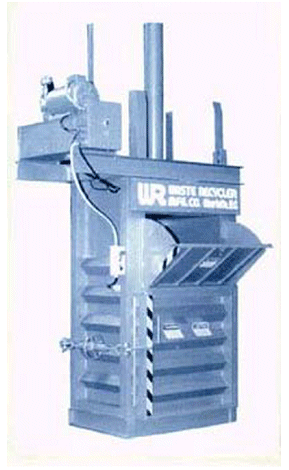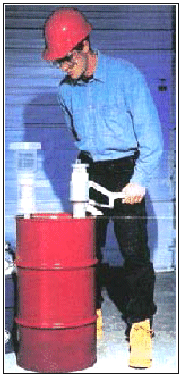| Overview: |
Aerosol can puncturing, crushing, and recycling is a way to avoid disposing of aerosol cans as solid or hazardous waste. Aerosol can puncture devices rupture and empty the cans to make them classifiable as "empty," as per U.S. EPA requirements. The processed cans are then no longer considered to be a hazardous waste and can be sold as scrap metal.
Aerosol can puncturing devices safely puncture the cans, capturing their contents for easy recycling or disposal. Spray nozzles are removed as well. A simple, low-capacity can operator puncturing unit does not require power and is manually operated. With the can secured inside a cylinder, the operator presses a handle, which causes a puncture pin to pierce the aerosol can. The can’s contents are then collected in a drum.
More sophisticated units have a pre-loader that moves aerosol cans into a 12-inch sealed cylinder. This cylinder is ruptured and crushed into a 1/2 inch thick wafer by a piston. The propellant and concentrate then pass through a check valve in the piston and are collected in a pressure tank. A scavenger system accepts the small amount of propellant remaining to reduce internal pressure to atmospheric before the cylinder is opened. The cans are discharged onto a well ventilated, drying conveyor where they remain for 10 to 15 minutes, before being collected in a container.
Sophisticated aerosol can puncturing devices can process more than 99% of aerosol cans for either safe disposal or recycling. Capacities range from 120 to 2,000 cans per hour. Available features of the more sophisticated units include explosion proofing, and electric, hot oil, and steam heaters to vaporize residual propellant.
Empty steel paint and aerosol cans are accepted by the steel industry for recycling. Aerosol cans must be completely empty, with the plastic lid removed (spray nozzles do not need to be removed for recycling). Residues remaining in aerosol cans are subject to federal (40 CFR 261.7) and state regulations. Can-puncturing processes may need to be licensed by state agencies or U.S. EPA. Puncturing cans may involve local air quality regulations; therefore consultation with city and county air quality agencies is advised. In most states, volatile organic compound (VOC) venting is regulated. Typically, aerosols use VOC propellants and hence the puncturing operation could result in release of these compounds to the environment. One example of a frequently used propellant is butane. To address this problem, some puncturing systems provide an activated carbon adsorption canister to capture any VOCs (not CFCs) released from the punctured can. However, the carbon has to be replaced and disposed of periodically.
|
| Compliance Benefit: |
Aerosol can puncturing, crushing,
and recycling can reduce the amount of hazardous and non-hazardous waste at a
facility. The decrease in hazardous waste helps facilities meet the requirements
of waste reduction under RCRA, 40 CFR 262 and Executive Order (EO)
13148, and may also help facilities reduce their generator status and lessen
the amount of regulations (e.g., recordkeeping, reporting, inspections, transportation,
accumulation time, emergency prevention and preparedness, emergency response) they
are required to comply with under RCRA, 40 CFR 262. Recycling the empty
metal cans will help facilities decrease the amount of solid waste going to landfills
and therefore, helps to meet the provisions of EO 13101 requiring executive
agencies (e.g., Department of Defense) to incorporate waste prevention and recycling into their daily
operations. Increased VOC emissions from aerosol can puncturing may contribute to
a facility's need for an air permit under 40 CFR 70 and 71.
Use of sophisticated aerosol can puncturing devices
may increase the use of electricity at the facility. Under EO 13123, facilities
are required to reduce energy consumption. In addition, quantities of hydraulic fluid
associated with the use of automated puncturing devices may increase a facility's
need to comply with SARA (40 CFR 355, 370) and EO 13148 reporting
requirements as well as spill plan requirements under 40 CFR 112. Finally,
the possibility exists that aerosol can crushing could be considered to be treatment
of a hazardous waste.
The compliance benefits listed here are only meant
to be used as general guidelines and are not meant to be strictly interpreted.
Actual compliance benefits will vary depending on the factors involved, e.g., the
amount of workload involved.
|
| Materials Compatibility: |
The residual contents of all aerosol cans being crushed must be compatible. Mixing aerosol can contents that are incompatible is not allowed. It is important to check material compatibly when disposing of many cans at once, especially when disposing of a group of cans that contain different products. The containers (55-gallon steel drum or other container) in which the residues are discharged should be designated and labeled for specific materials (e.g., paints, lubricants, etc.). Check with product manufacturers for compatibility within the same class of material, e.g., are two different types of paints compatible with each other in a disposal drum? The practice of designating drums for specific classes of materials also simplifies waste management and disposal.
|
| Safety and Health: |
Proper design, operation, and maintenance of the
equipment is required for its safe use. There are minimal health concerns regarding this process, but care must
be taken when pre-loading these cans for manual processing. Precautions must be taken and proper personal
protective equipment is recommended.
Consult your local industrial health specialist, your local health
and safety personnel, and the appropriate MSDS prior to implementing this technology.
|
| Benefits: |
- Reduces the volume of waste disposed in the landfill by up to 1.3% (U.S. EPA 1994).
- Renders a potentially hazardous waste non-hazardous.
- Revenue is generated from the sale of the cans as scrap metal.
- Typically requires only simple processing equipment.
|
| Disadvantages: |
- May require an air emissions permit.
- Training of equipment operators and waste generators will be required, so they can process the cans and separate the wastes properly.
- Aluminum must be segregated from steel.
|
| Economic Analysis: |
The cost elements of crushing and recycling aerosol cans are compared to landfill disposal. According to the Pollution Prevention Equipment Program, the cost of an aerosol can puncturer is approximately $800, for the small manual operated unit used for this analysis. Waste Control Systems Inc. sells the Aerosolv Model 5100. (Katec offers an automated unit that can range from $15K to $30K, which offers the user an enhanced efficiency capturing system and a larger working capacity.)
Assumptions:
- Aerosol can recycling is incorporated into the existing recycling program.
- Aerosol can recycling program has no impact on labor requirements for garbage collection and disposal.
- Capital Cost for smaller units (200 cans/hr): $775
- 10% of the cans processed are classified as a hazardous waste before processing.
- Aerosol cans processed for recycling: 0.5 ton/month
- Additional labor requirements for separation of aerosol cans: 2 hr/month
- Labor for system operation: 5 hr/month
- Labor rate: $30/hr
- Recycled steel market price: $0.05/lb or $100/ton
- Landfill fee: $40/ton
- Hazardous waste disposal fee for unprocessed hazardous waste aerosol cans: $2/lb
- Hazardous waste liquid disposal cost: $125/55-gallon drum
- Hazardous waste liquid generated from puncture, crush, and recycle system: One 55-gallon drum/yr.
Table 1. Annual Operating Cost Comparison for Diversion and Disposal of Aerosol Cans
| |
Diversion
|
Disposal
|
| Operational Costs: |
|
|
| Labor: |
$2,500 |
$0 |
| Landfill Disposal: |
$0 |
$240 |
| Hazardous Waste Disposal: |
$130 |
$2,400 |
| Total Operational Costs: |
2,630 |
2,640 |
| Total Recovered Income: |
$600 |
$0 |
| Net Annual Cost/Benefit: |
-$2,030 |
-$2,640 |
Economic Analysis Summary:
- Annual Savings for Aerosol Can Recycling: $610
- Capital Cost for Diversion Equipment/Process: $775
- Payback Period for Investment in Equipment/Process: < 2 years
Note: The economic analysis assumes that 10% of the unpunctured aerosol cans are considered hazardous wastes. However, in the event that a higher percentage of the cans are considered as hazardous wastes, this process will incur additional costs.
Click Here
to view an Active Spreadsheet for this Economic Analysis
and Enter Your Own Values.
To return from the Active Spreadsheet, click the Back arrow on the Tool Bar.
|
| NSN/MSDS: |
| Product |
NSN |
Unit Size |
Cost |
MSDS* |
| Aerosol Can Recycling System |
4250-01-393-7158 |
ea. |
$592.90 |
|
*There are multiple MSDSs for most NSNs.
The MSDS (if shown) is only meant to serve as an example. To return from the MSDS, click the Back arrow on the Tool Bar.
|
| Approving Authority: |
Appropriate authority for making process changes should always be
sought prior to procuring or implementing any of the technologies identified herein.
|
| Points of Contact: |
For more information
|
| Vendors: |
This is not meant to be a complete
list, as there may be other manufacturers of this type of
equipment.
Abar EnviroSystems
21000 Aurora Road
Cleveland, OH 44146-1010
Phone: (216) 587-0001
FAX: (216) 587-0000
Beacon Engineering Company
P.O. Box 129
Jasper, GA 30143
Phone: (706) 692-6411
FAX: (706) 692-3227
Katec
P.O. Box 3399
1728 Virginia Beach Blvd., #105
Virginia Beach, VA 23454
Phone: (757) 428-8822
FAX: (757) 428-5757
URL: http://www.aerosolv.com
Service: Supplier of the Aerosolv technology that has been approved by
the U.S. Navy, U.S. EPA, and the California EPA. See the link above for more details.
Macon Iron and Metal
P.O. Box 506
Macon, GA 31208
Phone: (478) 745-9817
FAX: (478) 743-9965
Service: Can recyclers
|
| Related Links: |
Do You Dispose of Aerosol Cans as Hazardous Waste? Navy Environmental Quality Fact Sheet
Aerosol Can Puncturer
|
| Sources: |
Mr. Michael Campbell, Katec, September 2002.
Mr. Michael Viggiano, Naval Facilities Engineering Service Center, February 1999.
U.S. EPA, Characterization of Municipal Solid Waste in the United States: 1994 Update.
|
| Supplemental: |
Picture of Aerosol Can, Puncturing, Crushing, and Recycling

Picture of Aerosol Can Puncturer

|


